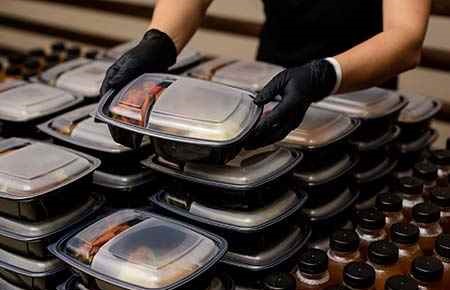
Food Preparation Worker
Summary
Food preparation workers perform many routine tasks under the direction of cooks, chefs, or food service managers.
What they do
Food preparation workers prepare cold foods, slice meat, peel and cut vegetables, brew coffee or tea, and perform many other food service tasks.
Food preparation workers typically do the following:
- Clean and sanitize work areas, equipment, utensils, and dishes
- Weigh or measure ingredients, such as meats and liquids
- Prepare fruit and vegetables for cooking
- Cut meats, poultry, and seafood and prepare them for cooking
- Mix ingredients for salads
- Store food in designated containers and storage areas to prevent spoilage
- Take and record the temperature of food and food storage areas
- Place food trays over food warmers for immediate service
Food preparation workers perform routine, repetitive tasks under the direction of cooks, chefs, or food service managers. To help cooks and other kitchen staff, they prepare ingredients for dishes by slicing and dicing vegetables and by making salads and cold food items. Other common duties include keeping salad bars and buffet tables stocked and clean.
Food preparation workers retrieve pots and pans, clean and store kitchen equipment, and unload and store food supplies. When needed, they retrieve food and equipment for cooks and chefs. In some kitchens, food preparation workers use a variety of commercial kitchen equipment, such as commercial dishwashers, blenders, slicers, or grinders.
In restaurants, workers stock and use soda machines, coffeemakers, and espresso machines to prepare beverages for customers.
Work Environment
The work is often strenuous. Food preparation workers may stand for hours at a time while cleaning or preparing ingredients. Some may be required to lift and carry heavy pots or unload heavy food supplies.
The fast-paced environment in kitchens can be hectic and stressful, especially during peak dining hours. Therefore, food preparation workers must work well with cooks and other kitchen staff so that dishes are prepared properly and on time.
How to become a Food Preparation Worker
Food preparation workers typically learn through on-the-job training. No formal education or previous work experience is required.
There are no formal education requirements for becoming a food preparation worker.
Most food preparation workers learn through short-term on-the-job training, usually lasting several weeks. Trainees typically start by working under the supervision of an experienced worker, who teaches them basic kitchen duties. Training also may include basic sanitation and workplace safety regulations, as well as instructions on how to handle and prepare food.
Pay
The median hourly wage for food preparation workers was $11.92 in May 2019. The median wage is the wage at which half the workers in an occupation earned more than that amount and half earned less. The lowest 10 percent earned less than $8.76, and the highest 10 percent earned more than $17.07.
Job Outlook
Employment of food preparation workers is projected to decline 1 percent from 2019 to 2029.
Similar Job Titles
Deli Clerk (Delicatessen Clerk), Diet Aide, Dietary Aide, Dietary Assistant, Food Preparer, Food Service Aide, Food Service Worker, Nutrition Aide, Pantry Cook, Slicer
Related Occupations
Cooks (Fast Food), Food Server (Non-restaurant), Dining Room and Cafeteria Attendant and Bartender Helper, Maids and Housekeeping Cleaner, Meat/Poultry/Fish Cutter and Trimmer
More Information
The trade associations listed below represent organizations made up of people (members) who work and promote advancement in the field. Members are very interested in telling others about their work and about careers in those areas. As well, trade associations provide opportunities for organizational networking and learning more about the field’s trends and directions.
- American Culinary Federation
- International Council on Hotel, Restaurant, and Institutional Education
- National Restaurant Association
- UNITE HERE
Magazines and Publications
Food service workers perform customer service, food preparation, and cleaning duties… in food service establishments from fast food restaurants to hospitals and hotels. Counter attendants and baristas take orders, process payments, and serve food at fast food restaurants, snack bars, cafeterias, movie theaters, and coffee shops. They heat simple food items and assemble salads or sandwiches. Counter attendants also fill beverage orders and may prepare specialties, such as milkshakes and ice cream sundaes. Dining room and cafeteria attendants, also called bussers, clean and set tables, remove dirty dishes, and keep serving areas stocked with trays, dishes, and silverware. They may also fill water glasses and distribute dishes to diners. Bartender helpers clean bar equipment and glasses. These workers spend most of the time on their feet and often carry heavy trays. During busy dining periods, they are under pressure to serve customers quickly and efficiently. Minor injuries such as slips and burns are common. To reduce risks, workers often wear gloves, aprons, or nonslip shoes. Part-time work, seasonal work, and early morning or late evening hours are common… especially for fast food workers. Workers serving alcohol generally must be 18 years of age or older. Most food and beverage service workers receive short-term, on-the-job training. There are no formal educational requirements.
Content retrieved from: US Bureau of Labor Statistics-OOH www.bls.gov/ooh,
CareerOneStop www.careeronestop.org, O*Net Online www.onetonline.org
